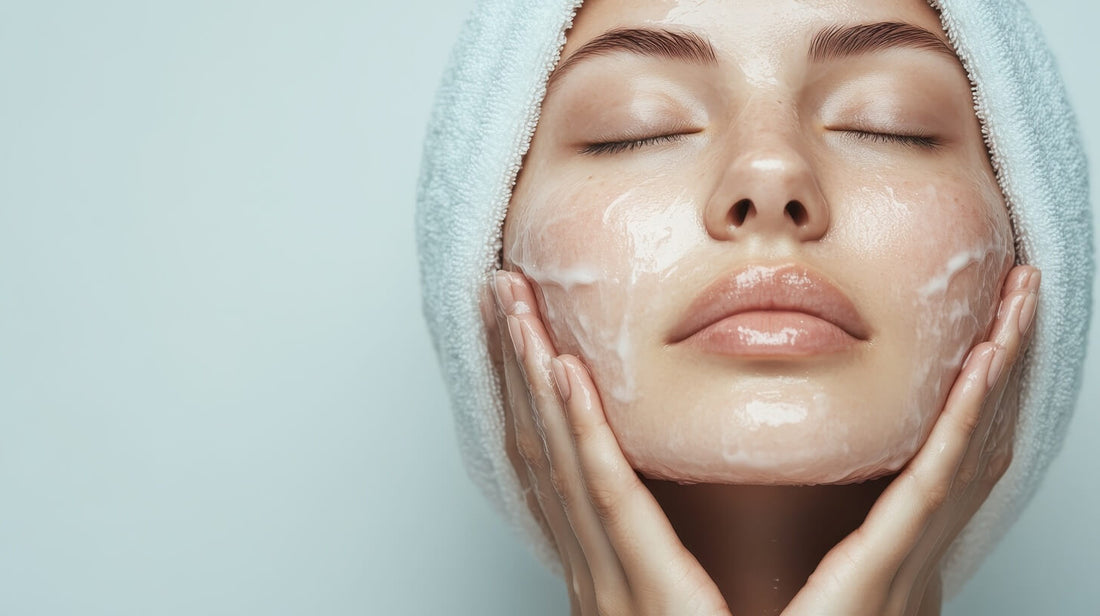
Can I Use Niacinamide With Tretinoin? A Dermatologist’s Guide To Combine Them Safely
Written by Dr Shamsa Kanwal - Dermatologist
Updated on April 28th 2025
Are you experiencing redness, peeling, or sensitivity while using tretinoin? Tretinoin, widely used for acne and skin aging, can sometimes disrupt the skin barrier, leading to irritation. That’s where niacinamide comes in—it helps strengthen the skin, reduce inflammation, and improve tolerance to tretinoin.
But can you use tretinoin and niacinamide together without causing more irritation? It depends on your skin’s sensitivity. Tretinoin is a potent ingredient that accelerates skin cell turnover but can cause dryness, redness, and increased sun sensitivity, especially when first introduced. However, niacinamide can help strengthen the skin barrier and minimize these side effects. Applying niacinamide before or after tretinoin can support skin balance and enhance their combined benefits.
In this article, we’ll explore how to use niacinamide with tretinoin safely, the best order of application, and expert tips to get the most out of these powerhouse ingredients.
What Are Niacinamide and Tretinoin?
Before exploring how to use tretinoin and niacinamide together, let’s break down what these ingredients do for your skin.
What is Tretinoin?
Tretinoin is a topical retinoid derived from vitamin A [1]. It is widely used to treat acne, fine lines, hyperpigmentation, and uneven skin texture [2]. It works by speeding up cell turnover, which helps clear clogged pores, fade dark spots, and stimulate collagen production.
However, tretinoin can be irritating, especially during the initial weeks of use. Common side effects include dryness, peeling, and redness as the skin adjusts. Due to its potency, tretinoin is not recommended for individuals with sensitive skin, as it can exacerbate irritation and disrupt the skin barrier.
What Is Niacinamide?
Niacinamide is a form of vitamin B3 that offers multiple benefits for the skin [3]. It is known for its ability to:
-
Strengthen the skin barrier [4]
-
Reduce redness and inflammation [5]
-
Control excess oil
-
Boost hydration
-
Fade dark spots and even out skin tone [5]

Unlike tretinoin, niacinamide is gentle and well-tolerated by most skin types. It helps soothe irritation and improve overall skin health, making it an excellent ingredient to pair with tretinoin.
Can You Use Tretinoin and Niacinamide Together?
Now that we’ve covered what tretinoin and niacinamide are, you might be wondering, "Can I use tretinoin with niacinamide?" The answer is yes, but the application method is key. Niacinamide helps counteract tretinoin’s side effects, such as dryness, peeling, and irritation, making it easier for your skin to tolerate tretinoin.
Since tretinoin increases cell turnover, it can temporarily weaken the skin barrier, leading to heightened sensitivity. Niacinamide, on the other hand, reinforces the skin barrier, enhances hydration, and calms inflammation, reducing the discomfort often associated with tretinoin use.
However, improper layering or sudden introduction of both ingredients can cause excessive irritation. To reap the full benefits of niacinamide with tretinoin, it's essential to use the right application technique and gradual introduction into your routine.
Best Practices for Using Niacinamide and Tretinoin Together
Using tretinoin and niacinamide together can deliver excellent results if introduced correctly. Follow these dermatologist-approved techniques to maximize benefits while minimizing irritation.
Introduce Slowly and Adjust as Needed
If you're new to tretinoin and niacinamide, introducing them gradually will help your skin adjust without excessive irritation.
-
Start with tretinoin 2-3 times a week on non-consecutive days.
-
Use niacinamide daily to hydrate the skin and reduce inflammation.
-
If irritation occurs, pause tretinoin and continue using niacinamide to restore your skin barrier.
-
Slowly increase tretinoin usage once your skin adapts.
Dermatologist Tip: If irritation persists, switch to a lower tretinoin concentration (0.01% - 0.03%) or apply a moisturizer before tretinoin to buffer its strength. For those with sensitive skin or frequent sun exposure, gentler alternatives like peptides and hydrolyzed glycosaminoglycans can promote skin renewal with less irritation. Even with SPF 50, retinoids including tretinoin, increase sun sensitivity—making reapplication every two hours essential.
Use Niacinamide in the Morning and Tretinoin at Night
One of the simplest ways to prevent irritation is by applying niacinamide in the morning and tretinoin at night.
Morning Routine
Apply niacinamide to strengthen the skin barrier, hydrate the skin, and reduce redness. Since niacinamide helps regulate oil production, it can also prevent excess shine throughout the day.
Night Routine
Apply tretinoin in the evening, as this is when the skin’s natural repair process is most active. Since tretinoin increases sun sensitivity, nighttime use helps reduce the risk of irritation and UV damage.
Why this works
This method prevents dryness, irritation, and sensitivity while allowing both ingredients to work optimally.
Apply Niacinamide Before Tretinoin in the Same Routine
If you prefer using both ingredients in the same routine, the correct layering order is essential. Applying niacinamide before tretinoin helps fortify the skin, reducing the risk of irritation.

Step-by-Step Application
-
Cleanse: Use a gentle, non-stripping cleanser with soothing ingredients like PeachCalm and SyriCalm.
-
Apply Niacinamide: Use a few drops of a niacinamide serum to calm inflammation and hydrate the skin.
If you don’t have a niacinamide serum yet, or need one that supports your barrier during actives, Rush Hour Serum is a multi-tasking face serum that calms, hydrates, and restores skin barrier. It’s formulated with our proprietary GLOW7™ blend, including Niacinamide, Saccharide Isomerate, SEPIBLISS FEEL, and Unisooth ST-32, to strengthen the barrier and reduce redness. It’s especially beneficial when paired with tretinoin, helping your skin tolerate actives more comfortably while brightening post-acne marks. -
Wait a Few Minutes: Allow niacinamide to fully absorb before moving on to tretinoin.
-
Apply Tretinoin: Use only a pea-sized amount to avoid overuse.
-
Moisturize: Finish with a hydrating moisturizer containing ingredients like Saccharide Isomerate, PeachCalm, SyriCalm, SEPIBLISS FEEL, and Sharohyal Snail Veg to soothe and protect the skin barrier.
Use Moisturizer Sandwich Method
For those struggling with tretinoin irritation, the moisturizer sandwich technique can help buffer its strength while still delivering results.
How It Works
-
Cleanse your face and pat dry.
-
Apply niacinamide and allow 20-30 minutes for full absorption.
-
Apply a lightweight, fragrance-free moisturizer and wait 10-15 minutes to reduce sensitivity.
-
Apply a pea-sized amount of Tretinoin and spread it evenly.
-
Follow with another layer of moisturizer to lock in hydration.
Why this helps
This method creates a protective barrier, reducing tretinoin's intensity and preventing excessive dryness.
Choosing the Right Products for Your Skin Type
Not all tretinoin and niacinamide formulations work well together. Choosing the right products based on your skin type can improve tolerability.
| Skin Type | Best Niacinamide Product | Best Tretinoin Option |
|---|---|---|
| Oily Skin | Lightweight serum (4–5% niacinamide) | Gel-based tretinoin (0.025–0.05%) |
| Dry Skin | Moisturizer (2–5% niacinamide) | Cream-based tretinoin (0.025–0.05%) |
| Combination | Serum on oily zones, moisturizer on dry | Microsphere tretinoin (0.04% gel) |
| Sensitive Skin | Fragrance-free cream (2–4% niacinamide) | Gentler tretinoin alternatives like peptides and hydrolyzed glycosaminoglycans |
Ingredients to Avoid When Using Tretinoin and Niacinamide
To prevent excessive irritation, avoid using tretinoin with:
Strong Acids
Strong acids, such as glycolic, salicylic, and lactic acid, can cause over-exfoliation, leading to increased sensitivity, redness, and peeling.
Benzoyl Peroxide
Benzoyl peroxide may deactivate tretinoin, reducing its effectiveness while also heightening irritation.
Harsh Physical Exfoliants
Harsh physical exfoliants further disrupt the skin barrier, making the skin more prone to dryness and inflammation.
Dermatologist Tip: Always do a patch test before introducing new skincare products to see how your skin reacts.

Possible Side Effects of Using Tretinoin and Niacinamide Together
While niacinamide and tretinoin work well together, some individuals may still experience side effects, especially during the initial adjustment period. Understanding these potential reactions can help you manage them effectively.
-
Dryness and Flaking – One of the most common side effects of tretinoin is increased skin dryness and peeling, particularly when used too frequently or in high concentrations.
-
Redness and Irritation – Tretinoin speeds up cell turnover, which can lead to sensitivity, redness, and discomfort, especially for those with dry or sensitive skin.
-
Breakouts (Purging) – Some users experience temporary breakouts as tretinoin brings underlying clogged pores to the surface. This is known as "purging" and typically resolves within a few weeks.
If you experience excessive irritation, consider replacing it with gentle alternatives like peptides and hydrolyzed glycosaminoglycans.
Common Mistakes to Avoid When Using Niacinamide with Tretinoin
Here are a few common mistakes to avoid when using tretinoin with niacinamide:
|
Mistake |
Why It’s a Problem |
Solution |
|---|---|---|
|
Applying Tretinoin on wet skin |
Increases irritation & dryness |
Wait until skin is completely dry before applying |
|
Skipping Moisturizer |
Leads to excessive dryness and peeling |
Always use a hydrating moisturizer |
|
Using High-Strength Tretinoin too soon |
Can cause peeling & redness |
Start with a lower strength and increase gradually |
|
Not wearing sunscreen |
Increases risk of sunburn & damage |
Use SPF 50+ daily and reapply every 2 hours if outdoors |
Who Should Be Cautious When Using Tretinoin and Niacinamide Together?
While tretinoin and niacinamide can be a good combination for improving skin texture and reducing signs of aging, they may not be suitable for everyone. If you have sensitive skin, rosacea, eczema, or dryness, using them together may increase irritation. Here’s how to adjust your routine based on your skin type.
Individuals with Sensitive Skin
Sensitive skin reacts quickly to new skincare ingredients, making it more prone to redness, dryness, and irritation from tretinoin’s exfoliating effects. Strengthening the skin barrier beforehand can help improve tolerance, and niacinamide is particularly beneficial for this purpose.
Since tretinoin is often too harsh for sensitive skin, gentler alternatives such as peptides or hydrolyzed glycosaminoglycans are recommended. To prepare the skin, use niacinamide daily for a few weeks before introducing these alternatives. Applying a hydrating moisturizer before and after use helps reinforce the skin barrier, minimize irritation, and promote a smoother adjustment period.
Individuals with Rosacea or Eczema
Rosacea and eczema indicate a weakened skin barrier, making the skin more prone to redness, burning, and dryness. While niacinamide can help strengthen the barrier and reduce inflammation, tretinoin may be too harsh and should be introduced cautiously—or avoided altogether in cases of eczema.
For Rosacea
Avoid tretinoin during flare-ups, as it can worsen redness and peeling. Instead, focus on barrier repair with niacinamide, which helps calm inflammation and improve skin resilience. If your skin feels stable and well-hydrated, you may introduce a low-strength tretinoin sparingly, starting once or twice a week.
For Eczema
Tretinoin is generally not recommended, as it can cause excessive dryness and irritation. Instead, prioritize barrier-strengthening ingredients like Sharohyal Snail Veg or Ceramides to maintain hydration and reduce sensitivity. Niacinamide can be beneficial in small concentrations, but it should be introduced gradually to avoid irritation.
General Tips
Avoid daily use of actives and prioritize soothing ingredients such as PeachCalm or SEPIBLISS FEEL to reduce sensitivity and support skin recovery. A barrier-repair moisturizer with ceramides, peptides, and calming agents like SyriCalm can further help in reducing irritation and strengthening the skin.
What to Do If You Have Irritation from Niacinamide and Tretinoin?
Using niacinamide and tretinoin together can be beneficial, but some individuals may experience irritation, redness, or dryness. If you notice discomfort, follow these dermatologist-recommended strategies to soothe your skin:
Opt for a Gentler Alternative
If tretinoin remains too harsh, consider switching to milder alternatives like peptides and hydrolyzed glycosaminoglycans. These ingredients promote cell turnover without disrupting the skin barrier.
Use the Moisturizer Sandwich Method
Applying a layer of moisturizer before and after tretinoin can create a protective buffer, reducing its intensity and minimizing irritation.
Avoid Harsh Skincare Products
Stop using strong exfoliants, acids (like glycolic or salicylic acid), and benzoyl peroxide while adjusting to tretinoin and niacinamide to prevent further irritation.
Focus on Barrier Repair
Incorporate hydrating and soothing ingredients such as ceramides, PeachCalm, Unisooth ST, and Sharohyal Snail Veg to strengthen the skin barrier and accelerate healing.
Consult a Dermatologist
If irritation persists despite adjustments, consult a dermatologist for a tailored skincare regimen that suits your skin’s needs.
Dermatologist Recommended Ingredients to Support Tretinoin and Niacinamide
When using tretinoin and niacinamide together, supporting your skin with science-backed, barrier-strengthening ingredients is essential. While tretinoin accelerates cell turnover for clearer, younger-looking skin, it can also lead to redness, dryness, and irritation. The right hydrating and soothing ingredients can help counteract these effects, ensuring a balanced and effective skincare routine.
Saccharide Isomerate
Tretinoin can strip moisture from the skin, leading to tightness and flaking. Saccharide Isomerate is a moisture-binding ingredient that provides long-lasting hydration, preventing skin from becoming overly dry or irritated [6].
Unisooth ST
Unisooth ST is an anti-inflammatory complex that soothes and restores irritated, sensitive skin. This makes it particularly beneficial for those experiencing redness and discomfort from tretinoin use.
Sharohyal Snail Veg
A plant-based alternative to snail mucin, this ingredient delivers deep hydration, strengthens the skin barrier, and helps soothe dry, irritated skin without clogging pores. It’s an excellent vegan-friendly option for repairing and maintaining skin health.
PeachCalm
A botanical extract rich in antioxidants, PeachCalm effectively reduces redness and calms inflammation. It is particularly beneficial for individuals with sensitive skin that reacts to strong actives like tretinoin.
FAQs: Using Niacinamide with Tretinoin
Here are a few of the most common questions about using Niacinamide with Tretinoin:
-
Can I mix tretinoin and niacinamide together before applying?
No, it’s not recommended to mix tretinoin and niacinamide together before application. These ingredients work differently, and combining them prematurely may affect their stability. Instead, apply niacinamide first, allow it to fully absorb, and then apply tretinoin.
Replacing tretinoin with alternatives like peptides and hydrolyzed glycosaminoglycans is a better option. These gentler ingredients offer anti-aging benefits without the risk of irritation or barrier damage.
-
How long does it take to see results when using both niacinamide and tretinoin?
The timeline for visible results varies based on individual skin type, condition, and tolerance:
Niacinamide: Early benefits, such as improved hydration and reduced redness, can be seen within 2–4 weeks as it strengthens the skin barrier and calms inflammation.
Tretinoin: More noticeable improvements in skin texture, acne, and fine lines typically take 8–12 weeks, as it works by increasing cell turnover and stimulating collagen production. Consistency and a supportive skincare routine are key to achieving optimal results.
-
Can I use niacinamide and tretinoin around my eyes?
Niacinamide is gentle and safe for the under-eye area, helping to strengthen the skin barrier and reduce redness. However, tretinoin is not recommended for use around the eyes, as the delicate skin in this area is more prone to irritation, dryness, and sensitivity. To keep the eye area hydrated and protected, apply a nourishing eye cream as part of your routine.
-
How long should I wait between applying niacinamide and tretinoin?
For optimal absorption and minimal irritation, wait about 10-15 minutes after applying niacinamide before applying tretinoin. This ensures each ingredient has time to absorb fully without affecting the other’s efficacy.
-
Is it safe to wear heavy makeup while using tretinoin and niacinamide together?
Yes, but be cautious. Tretinoin increases skin sensitivity, making it prone to dryness and irritation under heavy makeup. To protect your skin:
-
Use a hydrating primer before makeup.
-
Choose non-comedogenic, fragrance-free foundations.
-
Remove makeup gently with a non-stripping cleanser and follow up with a nourishing moisturizer.
Conclusion
While tretinoin promotes skin renewal and targets acne, it may also cause irritation and dryness. Niacinamide complements tretinoin by strengthening the skin barrier, reducing inflammation, and regulating oil production, making it an excellent option for minimizing sensitivity.
To get the best results from tretinoin and niacinamide, follow a gradual introduction strategy and use barrier-supporting ingredients to maintain hydration and comfort. However, skincare is not one-size-fits-all. If you experience persistent irritation or are unsure how to incorporate these ingredients, consulting a dermatologist can help you create a personalized routine tailored to your skin’s needs.
References
https://www.academia.edu/download/61859667/AJBSR.MS.ID.00065620200122-73406-18qvndy.pdf
https://onlinelibrary.wiley.com/doi/abs/10.1046/j.1365-4362.1998.00433.x
https://onlinelibrary.wiley.com/doi/abs/10.1002/9783527681754.ch3
https://www.mdpi.com/2076-3921/10/8/1315
https://d1wqtxts1xzle7.cloudfront.net/86985210/98375-libre.pdf

 Hydration
Hydration Soothing
Soothing Radiance
Radiance Clarity
Clarity








